Authors do not to agree on the origins of the Yule Log tradition, some places it in Scandinavia at the time of Vikings, other around the 6th to 7th century Anglo-Saxon paganism like the English historian Henry Bourne, some finally after the Norman invasion of England in 1066.
The Yule Log Ceremony
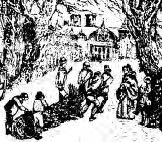 The original Yule Log Ceremony was a Norsemen festival celebrating the sun during the winter solstice, which occurs close to the time we celebrate Christmas today. The Yule Log was burned in honour of the gods and to bring good luck in the coming year. It usually came from the largest tree that could be found on the owner’s land or a neighbour’s property and was so massive that to haul it a team of horse or oxen was needed. It could not be purchased. It was burned on Christmas Eve accompanied by music and games and would last for many days. Each year a piece of the Yule Log would be saved and used to start the next year’s log.
The original Yule Log Ceremony was a Norsemen festival celebrating the sun during the winter solstice, which occurs close to the time we celebrate Christmas today. The Yule Log was burned in honour of the gods and to bring good luck in the coming year. It usually came from the largest tree that could be found on the owner’s land or a neighbour’s property and was so massive that to haul it a team of horse or oxen was needed. It could not be purchased. It was burned on Christmas Eve accompanied by music and games and would last for many days. Each year a piece of the Yule Log would be saved and used to start the next year’s log.
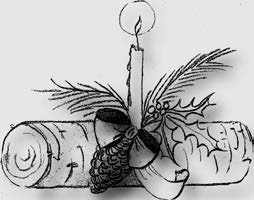 The tradition evolved through the years in Europe to become what it is today. In old England, a large log was brought to the manor or castle to burn for the twelve days of Christmas from Christmas Eve to Epiphany on January 6th. Today, those who have a smaller fireplace burn a small log on Christmas Eve whereas those who do not have fireplace use a small log to hold three candles that they light on Christmas Eve and every night until Epiphany.
The tradition evolved through the years in Europe to become what it is today. In old England, a large log was brought to the manor or castle to burn for the twelve days of Christmas from Christmas Eve to Epiphany on January 6th. Today, those who have a smaller fireplace burn a small log on Christmas Eve whereas those who do not have fireplace use a small log to hold three candles that they light on Christmas Eve and every night until Epiphany.
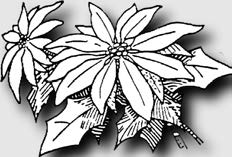 You have a choice. You can burn your Yule log like the English. Or if you don’t have a fire-place, you can eat it like the French. You can light a special candle as they do in Denmark and Norway. Or you can use a decorated log as a centrepiece like the Italian « ceppo ».
You have a choice. You can burn your Yule log like the English. Or if you don’t have a fire-place, you can eat it like the French. You can light a special candle as they do in Denmark and Norway. Or you can use a decorated log as a centrepiece like the Italian « ceppo ».
Blessing
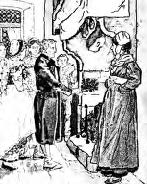 In France, there are reports of the Yule log tradition called bûche de Noël around the 12th century. Like the Norsemen and the English, they used a tree trunk, sometimes with the stump and the roots, that was cut before sunrise ; they decorated it with sea-son’s greenery, ribbons and berries. The head of the family would bless it with water and salt and the youngest member would light it with a piece of last year log. It would then burn slowly for at least 6 days. The tradition evolved towards smaller log and French being French it evolved toward foods in the 19th century hence the Bûche de Noël, as we know it today.
In France, there are reports of the Yule log tradition called bûche de Noël around the 12th century. Like the Norsemen and the English, they used a tree trunk, sometimes with the stump and the roots, that was cut before sunrise ; they decorated it with sea-son’s greenery, ribbons and berries. The head of the family would bless it with water and salt and the youngest member would light it with a piece of last year log. It would then burn slowly for at least 6 days. The tradition evolved towards smaller log and French being French it evolved toward foods in the 19th century hence the Bûche de Noël, as we know it today.
Besides oak, the traditional wood used by Scandinavian for their Yule log, other species like ash, pine etc. were used. Here is according to tradition the different wood species that were used and the magic they could bring :
Ash brings protection, prosperity, and health
Aspen invokes understanding of the grand design
Birch signifies new beginnings
Holly inspires visions and reveals past lives
Oak brings healing, strength, and wisdom
Pine signifies prosperity and growth
Willow invokes the Goddess to achieve desires
Autres articles
Avez-vous lu?
- On sait jamais
- Il était une Foi
- Sylvie Bouchard… peindre, peindre et encore peindre !
- Coopérative de solidarité santé, Bedford et région : 200 personnes s’informent
- Grand ménage à la frontière
- Définir la frontière
- Bornes, repères et nouvelle technologie
- La haute vitesse à Saint-Armand, c’est relativement possible
- La buche de Noël
- LA BÛCHE AUX MARRONS






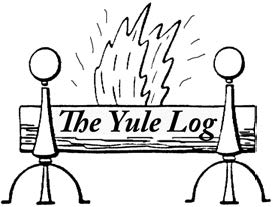










Laisser un commentaire
Nous n’acceptons pas les commentaires anonymes et vous devez fournir une adresse de courriel valide pour publier un commentaire. Afin d’assumer notre responsabilité en tant qu’éditeurs, tous les commentaires sont modérés avant publication afin de nous assurer du respect de la nétiquette et ne pas laisser libre cours aux trolls. Cela pourrait donc prendre un certain temps avant que votre commentaire soit publié sur le site.